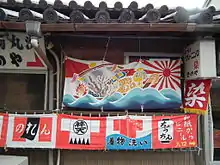Tairyō-bata
Tairyō-bata (大漁旗), also called tairyo-ki, are originally traditional Japanese fisherman's flags flown by boats to signify a large catch of fish in returning its port.[1] There are several local aliases, including Furai-ki (福来旗) in Sanriku Coast area.[2]

.jpg.webp)
Today, they are used as a decorative flag on vessels as well as for festivals and events, celebrating longevity, and had become the symbol of recovery from 2011 Tōhoku earthquake and tsunami in Tōhoku region.[2]
Literally translated as "big catch flag", each rectangular flag bears an intricate design specific to the company or boat, typically involving bright colors and ocean motifs. Many of these flags can be seen in the coastal communities of Japan. The Shiyogama Shrine in the Sendai region issues tairyo-bata to new-born infants, apparently as a jokey reference to the baby being a big catch.
References
- 広辞苑 [Kōjien] (4 ed.). Iwanami Shoten. 1988.
- "復興の象徴、大漁旗ずらり 宮城で展示イベント" [The symbol of recovery: A line of Tairyō-bata flags]. Sankei Shinbun. July 27, 2019. Retrieved September 21, 2020.
| Wikimedia Commons has media related to Tairyō-bata. |